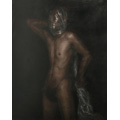"Mihitsu no koi"
Kumiko Otomo
August 31 - September 18, 201612:00-19:00
closed on Mondays and Tuesdays
Bambinart Gallery is pleased to present "Mihitsu no koi", a solo exhibition featuring works by Kumiko Otomo, which will run from August 31 – September 18, 2016. Otomo was born in Fukushima Prefecture in 1979. Upon graduating from a fashion design school in Japan, she then started working with a design firm for a few years before deciding to move to the United States. Her departure to the U.S. was scheduled for the 13th of September, 2001, but was delayed until the end of the month due to the 9/11 terrorist attacks in New York. Though her friends and family asked her to reconsider, she continued forward with her plans and moved to New York on her own. While in the U.S., Otomo worked in the local publishing industry and also freelanced as a graphic designer. During this time she increasingly became aware of the different interpretations of genders between the U.S. and Japanese cultures.
She decided to return to school and enrolled at the School of Visual Arts (New York) where she studied life drawings and honed her academic style of painting. After graduating in 2012, she returned to Japan to witness her home country again with her own eyes and to pursue and further develop her own style. She received a Master's degree in Arts at Tama University and now devotes her time to her projects, based in Tokyo. This is her second exhibition after her first, "The Paper Knife was Made", was held at Bambinart Gallery in October, 2014.
Since her last exhibition, the gallery has displayed her work exploring the soul within the void of despair created by sufferance and conflict, which is Otomo's core concept shaped by her existential underlying thoughts. These fundamentals of her work do still manifest in this exhibition, but this time, the art work is focused on the willful negligence, which means "Mihitsu no koi" in Japanese. The surrealism Otomo felt after the New York terrorist attacks and the 2011 earthquake in Japan that she hasn’t actually experienced, combined with her distant feelings toward her home town of Fukushima and about the family relationship - is often found in her new work. The work in this exhibition were produced by Otomo as she embraced the continuously expanding physical and psychological distance after 10 years of living in New York along with other pieces that had not been finished, which she has refined further.
Whether the sin is intended or not
The title of my second solo exhibition, “Mihitsu no Koi” (Latin: Mens Rea), is a term found more commonly in criminal law parlance, and is also the title of a play from Kobo Abe, a Japanese novelist and playwright whose works often focused on human suffering against isolation and loss of identity.
“Mihitsu no Koi” refers to a psychological state in which one’s thoughts or intentions alone is enough to constitute as a crime. In other words, one can perform a series of acts or tasks with no cruel intentions behind them, but these acts can ultimately lead to the crime. I can stab someone with a sharp paper knife and not inflict any harm, but my thinking is, “He/she might die and I wouldn’t mind it at all.”
I wouldn’t interpret “Mihitsu no Koi” solely as only a legal term here though. “Mihitsu no Koi” is a statement of intention, but it’s extremely challenging for a third person to gauge the true intention or presence of guilt in one’s mind. We can’t read each other’s minds. Only we, ourselves, individually, can look into our own minds to find the true meaning behind our thoughts.
We experience this often in our every day lives. We often say, “I didn’t mean it,” or, “it happened without my intention.” On the surface it appears as though we don’t know what will happen, but I believe these unconscious acts could be explained as a form of intentional acts, abandonment, and expression of despair. With each act our minds are benumbed, bit, by bit, until it eventually becomes a habit we repeat on daily basis that we’re completely oblivious to. Strangers probably won’t see or notice it, but will we see it? At that point we’re either completely ignorant or we’ve reached the point where we can’t tell if we’re deceiving ourselves or not anymore. In either case, the condition will continue to grow like a cancer in otherwise healthy minds, gradually and involuntarily.
”All the actions a man may take in order to create himself as he wills to be.” – Jean-Paul Sartre, “Existentialism is a Humanism (1946)”
According to Sartre’s existentialism concept, we have no given essential nature or qualities. We create ourselves through our behavior and actions. We are free and our freedom is limitless. Therefore, we have no valid excuses or escape routes. We are totally responsible for our own nature and choices, not anyone else.
I read Sartre’s words as: Once we have “Mihitsu no Koi”, we will became sinful, inferior existence whatever reasons we may have.
The works featured in this exhibition are expressions of this knowing and fundamental concept that shapes who we are. Through my own experiences, achievements and failures, I’m revisiting Sartre’s profound lessons and coming away with more sophisticated vision of my own, and it’s through this refined lens which helped to inform and reshape the direction of my recent unfinished work and latest new work.
Kumiko Otomo
information :
"Mihitsu no koi"
Kumiko Otomo
August 31 - September 18, 201612:00-19:00
closed on Mondays and Tuesdays
Venue:Bambinart Gallery
B107 3331 Arts Chiyoda
